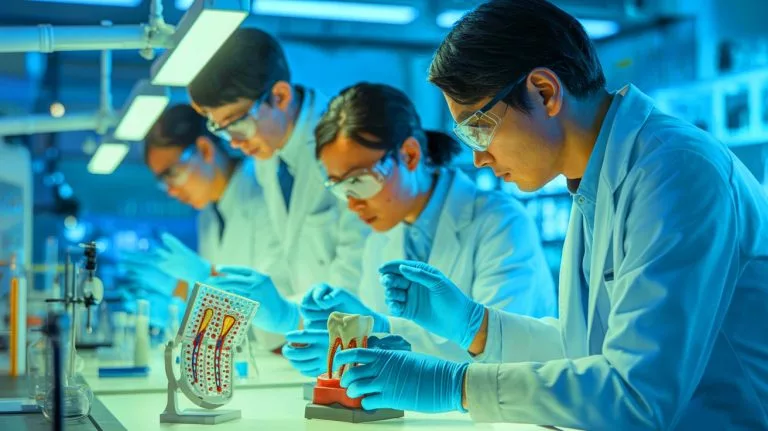| IN A NUTSHELL |
|
For decades, dental medicine has relied on mechanical solutions to address the absence of teeth, from implants to dentures. Now, a team of Japanese researchers is exploring the potential of molecular biology to regenerate human dentition. This experimental protocol could soon redefine therapeutic standards. The prospect of teeth regrowing, once relegated to the realm of fiction, is now entering the clinical trial stage. With advancements in regenerative medicine, the possibility of teeth regrowth is becoming a tangible reality. This article delves into the intricacies of this groundbreaking research and its potential implications for dental health.
The Long-Standing Dream of Dental Regeneration
In most mammals, teeth emerge in one or two generations. Humans develop two sets of teeth: baby teeth and permanent teeth. However, a third set of embryonic teeth remains dormant in our gums, never surfacing due to complex biological mechanisms. Unlike crocodiles or sharks, human dentition does not spontaneously regenerate. This limitation is partly due to the structure of teeth. Although composed of minerals similar to bones, teeth are covered with enamel, a hard layer that prevents natural reconstruction. Even minor fractures in teeth are irreversible.
Modern dentistry compensates for this limitation with implants, prostheses, or grafts. However, none of these techniques can restore a living, functional, and rooted tooth like a natural one. Despite advancements in dental technology, the field has long aspired to achieve true dental regeneration. The prospect of regrowing teeth would revolutionize dental care, offering a solution that closely mimics natural dentition. This dream, which has persisted for centuries, is edging closer to reality through scientific innovation.
A Promising Japanese Breakthrough
Since 2018, a Japanese team led by Professor Katsu Takahashi at Kitano Hospital, in collaboration with Kyoto University, has been working on an antibody that can reactivate dental growth. Their target is a protein called USAG-1, which inhibits dormant dental buds. By blocking this molecule, the researchers have successfully grown new teeth in mice and ferrets, animals with dental structures similar to humans. Encouraged by these results, the team launched a clinical trial in September 2024 involving thirty adult men aged 30 to 64, all with at least one missing tooth.
The trial aims to evaluate the safety and efficacy of the treatment, administered intravenously, over eleven months. This research could pave the way for broader application. According to reports, the team plans to test the molecule on children suffering from agenesis, a congenital absence of teeth affecting about 1% of the population. Researchers hope to commercialize this treatment by 2030. If proven safe, this innovation could eventually replace some dental prostheses, especially for young patients.
Challenges to Overcome Before Widespread Use
While initial results are promising, several challenges remain before dental regrowth can be widely implemented in humans. One of the major hurdles is the shape of the regenerated teeth. In rodents or ferrets, the teeth that emerge due to this treatment do not always match the original anatomical type. For optimal chewing, it is not enough to regrow a tooth; it must form in the right place with the correct structure. Ensuring the appropriate shape and alignment of new teeth is crucial for functionality.
Moreover, the fine-tuning of proteins involved, especially BMP and Wnt, poses systemic risks. These molecules contribute to the growth of various organs, and broad alterations could lead to side effects in other tissues. The team, therefore, focuses on a targeted action solely on USAG-1 inhibition to avoid disrupting the body’s overall balance. Ethical and regulatory considerations also arise. Should this treatment be offered to healthy patients seeking to avoid implants? At what age should it be administered? And at what cost? Initially, the priority is to correct congenital anomalies, but extending the treatment to more common cases, such as loss due to cavities or accidents, is already being considered.
Transforming the Landscape of Dental Medicine
This experimental project challenges the traditional boundaries of dental medicine, questioning the notion that certain body parts cannot be repaired. If clinical trials confirm their potential, these antibodies could eliminate the need for implants in favor of a new regenerative medicine. The implications are profound, potentially transforming how dental care is approached and administered. As research progresses, the field of dental regeneration may soon become a cornerstone of modern medicine, offering hope to millions worldwide.
The advent of dental regeneration marks a significant shift in how we perceive and address dental health. This innovative approach not only presents a solution to replace missing teeth but also opens new avenues for understanding and manipulating biological processes. As science continues to push the boundaries of what is possible, one question remains: how will society adapt to and integrate these groundbreaking advancements in dental medicine?
Did you like it? 4.5/5 (30)







Wow, this is amazing! Goodbye dentures and hello natural teeth! 🦷✨
Wow, will this work for wisdom teeth too? 🤔
Great news! Could this be the end of dentures? 🦷
How long before this treatment is available to the public? Can’t wait! 🕒
Is this safe for everyone, or are there any side effects?
Is this really safe? What about potential side effects? 🤔
Thank you, Japan! You’re leading the way in medical innovation. 🇯🇵
I hope dental insurance will cover this new technology. 💸
If this works, dentists might have to find new jobs! 😂
Why only test on men? Are women’s teeth not important? 😒
Can we expect this treatment to be affordable for the average person?
Sounds like science fiction, but I’m all for it! 🛸
What about people with dental anxiety? Could this be a less invasive option?
Thank you, Japan, for leading the way in dental innovation! 🇯🇵